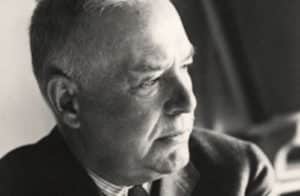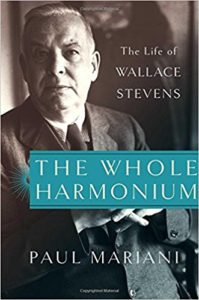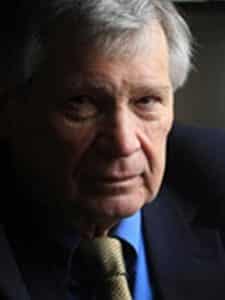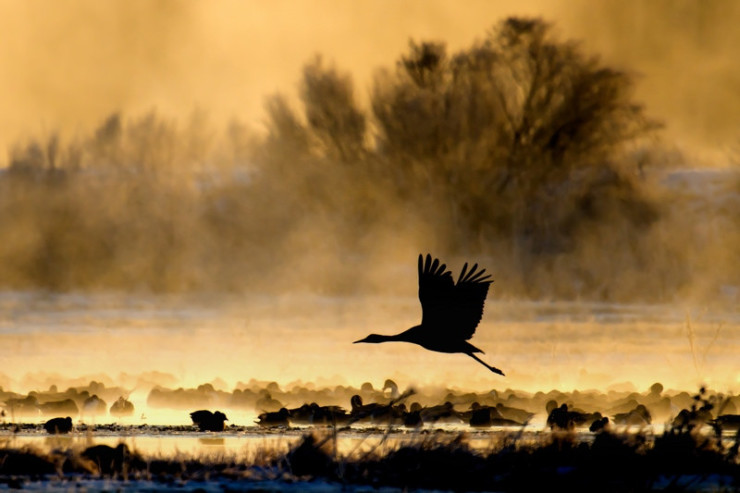The Whole Harmonium
Wallace Stevens (1879-1955) won two National Book Awards and the Pulitzer Prize for poetry, along with the Bollingen Prize and the Frost Medal. He was one of the American poets who were considered the high priests of literary modernism, along with T.S. Eliot, William Carlos Williams, and Robert Frost. He was a presence in poetry for more than four decades and had an enormous impact on poetry’s substance and direction.
Literary studies of his poetry abound. Several biographies of Stevens were written in the 1980s and a few in the 1990s. Twenty years after the last major biography, Paul Mariani has published The Whole Harmonium: The Life of Wallace Stevens.

Wallace Stevens
Mariani is especially well suited for the task. A poet himself, he has published seven collections of poetry and numerous nonfiction works. His biographies include William Carlos Williams: A New World Naked (1981); Dream Song: The Life of John Berryman (1990); Lost Puritan: The Life of Robert Lowell (1996); The Broken Tower: A Life of Hart Crane (1999); and Gerard Manley Hopkins: A Life (2008).
So what kind of Wallace Stevens emerges from Mariani’s biography?
First, Mariani gives us Stevens the poet and Stevens the philosopher of aesthetics. The two can’t really be separated. Stevens explored aesthetics as much as if not more than most other subjects. As a young man working in New York City after his graduation from Harvard, he was strongly influenced not only by poets but also by the contemporary art scene. He was in his early 30s when the New York Armory Show rocked the art world (and the American public) in 1913. He was friends with artists like Marcel Duchamp and Man Ray and poets like William Carlos Williams.
Making use of journals, letters, published articles, books, and earlier biographies (the bibliography is extensive), Mariani analyzes Stevens’s major poems, the route his poetry took to publication, and how his theories of aesthetics developed. This is Stevens and his impressive intellect.

His work required him to travel extensively, all over the eastern United States, the Midwest, and Texas, and he maintained a blistering travel schedule for a long time. The schedule had occasional benefits to his poetry, such as stopping by the offices of Harriet Monroe at Poetry magazine when he was in Chicago. But while he was often encouraged to teach or pursue a more academic profession, he chose to stay with his insurance company, eventually reaching the office of vice president of the Surety Division.
And third, Mariani portrays Wallace Stevens the family man, and it is not an altogether flattering portrait. His parents did not attend his marriage to Elsie in their hometown of Reading, Pennsylvania, as they did not consider it a suitable match. He broke with his father over it, and he didn’t see him again until his father’s funeral. He was not especially close to his two brothers or his two sisters, but he would grow closer to their children after his siblings’ deaths.

Paul Mariani
About his relationship with his wife, Mariani states the facts and lets readers draw their own conclusions. While there’s not even a wisp of a rumor of unfaithfulness, it’s clear that Stevens was unhappy in his marriage. Elsie rarely traveled with him, even for vacations; Stevens loved his trips with his drinking friends to Key West and similar points south. And his drinking often begat boorish behavior, such as when he insulted Ernest Hemingway and paid for it with black eyes.
Stevens left behind an extensive writing record: eight poetry collections published during his lifetime, including The Collected Poems, published in 1954 (which won both the National Book Award and the Pulitzer Prize), and a collection of essays, The Necessary Angel (1951). Works published after his death include Opus Posthumous (1957), Collected Poetry and Prose published by the Library of America in 1997, and Selected Poems published by Alfred A. Knopf in 2009. His daughter Holly Stevens also edited his letters, published in 1966.
Stevens was a major presence in American poetry and letters. He was often controversial but never boring. He wrote in the flood time of literary modernism and helped shape it and channel it. In The Whole Harmonium, Paul Mariani has told his story well.
Related:
Wallace Stevens and Walking the Landscape
Walk to Work with a Poet: The Wallace Stevens Walk
Coloring Page Poems: The Snow Man by Wallace Stevens
Photo by Tucker Hammerstrom, Creative Commons, via Flickr. Post by Glynn Young, author of the novels Dancing Priest and A Light Shining, and Poetry at Work.
__________________________

“I require all our incoming poetry students—in the MFA I direct—to buy and read this book.”
—Jeanetta Calhoun Mish
- Poets and Poems: Paul Willis and “Orvieto” - October 23, 2025
- Poets and Poems: Gabrielle Myers and “Points in the Network” - October 21, 2025
- Poets and Poems: Christine Rhein and “Wild Flight” - October 16, 2025

Rick Maxson says
Glynn, I have this on order from Amazon. Your review has made me more excited to receive it. Stevens was responsible for my re-interest in poetry after having given up on it 20 years prior. I came across his poem Of Mere Being by accident while studying ritual behavior among various primary indigenous cultures for anthropology at Denison University. What struck me first about it were the lines The palm at the end of the mind,/beyond the last thought… Stevens’s treatment in poetry of reality and imagination captivated me in another poem, the title of which is something alone to contemplate deeply Reality Is An Activity of the Most August Imagination.
I’ve read Parts of a World by Peter Brazeau and the Letters, edited by his daughter Holly.
Reading Stevens almost requires one to read his life for full understanding, which might take a lifetime. He is only one of a few poets that I can read and reread without full understanding and still feel moved more than puzzled. I wish so much of his erstwhile public domain poems had not been renewed, so they could be shared in EDP.
Thanks for this introduction to The Whole Harmonium.
Glynn says
Rick, I first read his poetry almost 40 years ago, when a good friend gave me his. Collected Poems. He told me that if I wanted to be a good speechwriter, I needed to read three poets: Stevens, Eliot, and Yeats, the three great moderns.
Donna Falcone says
Always controversial but never boring! Hmmm…. you have made me want to look for this one! Thanks, Glynn!
Glynn says
One later poet said Stevens represented everything that was “wrong about the old patriarchy.” He sounds as if he could be something of a curmudgeon, and he definitely had his opinions.